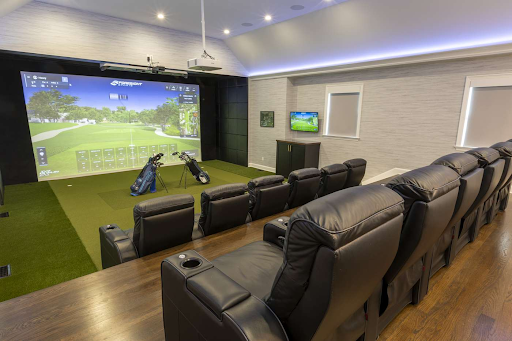Golf Simulators for Home Use in 2025: Top Features Every Serious Golfer Should Look For
Golf training has entered a new era, and 2025 is shaping up to be the most innovative year yet for home simulators. What once required a country club membership or professional facility is now available in spare rooms, garages, and basements across the world. For serious golfers aiming to improve consistency, refine technique, or simply play more often, a well-equipped home simulator is no longer a luxury—it’s a game-changing tool.
But not all simulators are created equal. With dozens of systems on the market, each offering different technologies, features, and performance promises, knowing what to look for is key to making a smart investment.
Precision Comes First: Advanced Ball and Club Tracking
Why Accurate Data Matters
For serious golfers, training without precise feedback is like practicing in the dark. The core of any high-performing simulator lies in its tracking system. Ball speed, spin rate, launch angle, club path, and face angle are just some of the essential metrics needed to analyze and improve every shot.
Whether you’re correcting a swing flaw or dialing in distances for your irons, accuracy is non-negotiable. Investing in a system that uses dual tracking technology—typically a combination of radar and high-speed cameras—ensures consistent, real-time feedback with minimal error.
Indoor vs. Outdoor Considerations
In 2025, more systems are designed specifically for home use, with compact tracking setups optimized for indoor environments. For those setting up a golf simulator for home, look for devices that deliver precise readings without requiring extensive room depth, which can be a limiting factor in smaller residential spaces.
Space-Saving, High-Impact Design
Compact Doesn’t Mean Compromised
Gone are the days when a home simulator required a full-scale buildout. Modern systems are now designed to maximize performance in minimal space. Short-throw projectors, retractable enclosures, and portable launch monitors make it possible to set up in garages, basements, or spare bedrooms without sacrificing quality.
Still, it’s important to verify ceiling height (ideally 9–10 feet for full swings) and room width to ensure comfortable setup and use. Compact systems that deliver on accuracy without needing commercial-level square footage are among the top choices for 2025.
All-in-One Packages vs. Custom Builds
Many brands now offer pre-configured packages for home users, bundling together projectors, screens, mats, and software. While these are convenient, some serious golfers prefer to customize each element. When tailoring a golf simulator for home, prioritize the quality of the hitting mat and impact screen—these components have a direct effect on swing feedback and durability.
Realistic Visuals and Immersive Gameplay
Graphics That Match Performance
Visual immersion isn’t just about aesthetics—it influences how you interpret shot shape and flight. In 2025, 4K resolution and lifelike rendering of real-world courses have become standard in premium simulators. This level of detail helps simulate real playing conditions and enhances engagement during practice or competitive rounds.
A good visual setup also minimizes screen lag and accurately displays draw, fade, and trajectory. If you’re working on shot shaping or playing virtual rounds under pressure, these features are critical for realism.
Playability Across Conditions
Some systems now simulate weather, wind, and course conditions to replicate real-life challenges. Practicing on a sunny links-style course one day and a rainy parkland layout the next helps sharpen adaptability—a skill that separates good players from great ones.
Training-Focused Software and Skill Development
Beyond Course Play
A simulator shouldn’t just entertain—it should educate. The top platforms for 2025 offer structured training modules, such as wedge distance control, tempo drills, and accuracy games. Some even provide personalized coaching plans or integrate with swing analysis apps.
For golfers committed to improvement, choose software that goes beyond simple course simulations. Look for systems that include driving range modes, club comparison tools, and performance summaries to track progress over time.
Integration with Coaching Tools
Leading simulators now connect with mobile apps or online coaching services. This allows users to share swing data with instructors remotely or review high-speed video paired with key metrics. If you train with a coach or plan to in the future, compatibility with third-party apps and services is worth considering.
Smart Features That Add Real Value
Adjustable Hitting Surfaces
To mimic real-world lies, many systems now include mats that simulate rough, sand, and fairway turf. These features allow you to practice escape shots and uneven stances, creating a more complete training environment at home.
If you’re building a serious golf simulator for home, consider adding a strike mat with modular inserts. It’s a small upgrade that can have a big impact on shot quality and course preparation.
Multiplayer and Family Modes
Even the most committed players enjoy mixing practice with play. Today’s simulators feature multiplayer modes, virtual tournaments, and customizable games for all skill levels. This is especially useful if the simulator will be shared with family or friends.
Look for systems that support multiple profiles and difficulty settings to accommodate everyone from scratch golfers to beginners.
What’s Ahead: Future-Proofing Your Setup
Modular Upgrades
With golf tech evolving rapidly, it’s smart to choose a simulator with modular components. The ability to swap out launch monitors, update software, or enhance your display means your setup can grow with your game.
Make sure your system includes ongoing firmware updates and access to new features without requiring a full replacement down the road.
Support and Longevity
Reliable support is a must. High-end simulators come with warranties, tech assistance, and community forums to help with setup and troubleshooting. When investing in a simulator designed for long-term use, responsive customer service can be as valuable as the system itself.
Conclusion
As golf simulators become more advanced and accessible in 2025, the options for home users have never been better. Serious golfers should focus on systems that deliver accurate data, immersive visuals, skill-building features, and smart space utilization.
By choosing a golf simulator that aligns with your goals and environment, you’ll transform your home into a high-performance training space—one that drives results and keeps your passion for the game alive, every single day.







